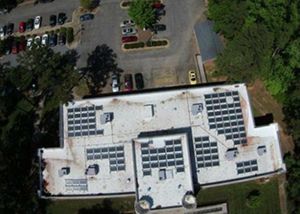
Aerial footage of solar panel installation at the
Robertson College-Community Center
Catawba College has completed Phase I of its solar installation, which will ultimately provide nearly one megawatt of solar electricity for the campus. The eight new solar electric systems will produce more solar electricity than that produced by all the other colleges and universities in North Carolina combined.
Catawba President Brien Lewis notes that the installation is a major undertaking with significant outcomes. "It is a giant step forward for our efforts on sustainability in general and to the energy reductions reflected in the American College and University Presidents Climate Commitment (ACUPCC) that Catawba signed in 2007," he says.
The installation, which includes solar electric systems, solar water heating systems, campus-wide water fixture replacements and extra insulation in the roofs, is projected to save the college nearly $5 million over the next 20 years and more than $11 million over 30 years.
It will also reduce annual carbon emissions by nearly 1,050 metric tons. That is the equivalent of taking 193 vehicles off the road each year.
"This a shining example of the great things that can be accomplished when our trustees, administration and others in our college community come together to both reduce our energy consumption and lower our carbon footprint," says John Wear, executive director of the Center for the Environment at Catawba.
Initially, roofs were replaced on Hayes Field House, Abernethy Physical Education Center, Robertson College-Community Center and Barger-Zartman, Stanback and Woodson residence halls in preparation for the installation. In addition, photovoltaic panels were installed on Woodson and Stanback halls, Robertson College-Community Center and Williams Music Building. Finally, preparation for solar water heating systems was completed on Woodson, Stanback and Barger-Zartman halls.
Phase II, which will likely begin in June, will include installing photovoltaic panels on Hayes Field House, Shuford Stadium parking lot and Abernethy Physical Education Center and solar water heating in Hayes Field House and Woodson, Stanback and Barger-Zartman halls.
It is uncommon for systems to be mounted on existing rooftops and parking lots, as Catawba's is, says Mike Nicklaus, president of Innovative Design, the project's consultant and facilitator. More often, the projects are installed on large field areas. "Catawba's project is significant because it doesn't take up additional land resources," he says.
